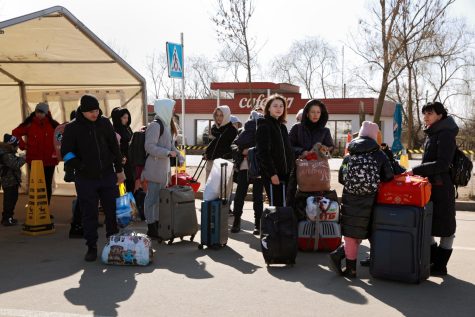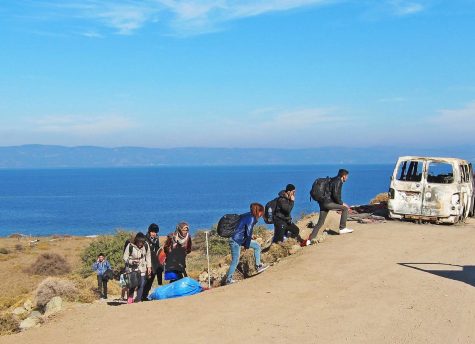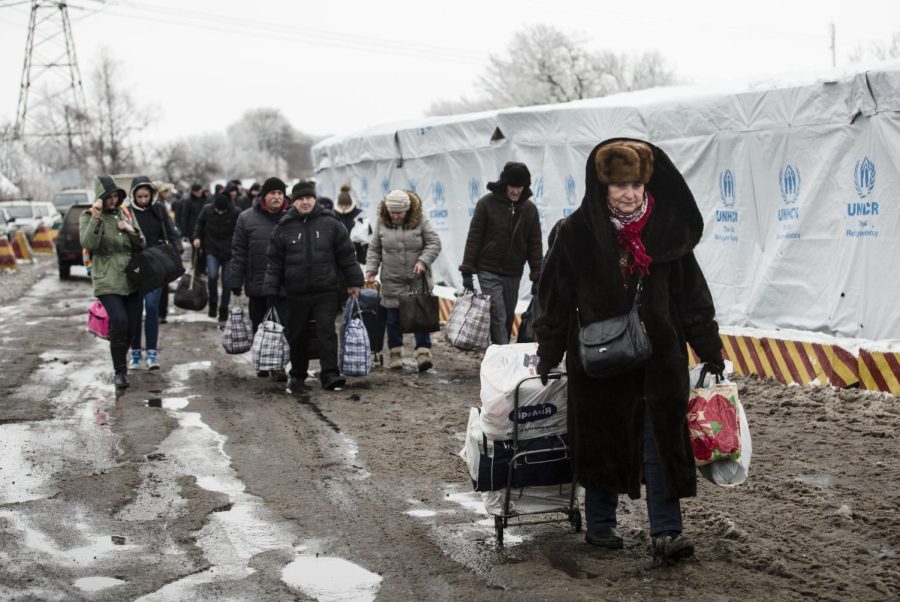Why We’ve Only Had a Make Sale for Ukraine
Ukrainian refugees rush towards a bus stop at a border crossing point in the Mayorsk, Donetsk region.
On March 25, Ms Mallor hosted Milken’s first make sale. Students and teachers crowded the amphitheater and adjacent walls with tables laden with cookies, cupcakes, notebooks, hair ties, custom-made greeting cards, and homemade art. Students crowded around the tables, whipping out credit cards and Venmo accounts in order to pay for their treats. But this money was not going to Yozma or another Milken-based group: all of the proceeds of the make sale went to aide Jewish Ukrainian refugees (there are approximately 400,000 Jews in Ukraine) though the Joint Distribution Committee.
Ever since Russia invaded Ukraine in February of 2022, there has been a flood of refugees out of the country, a crisis the likes of which have not been seen in Europe since World War II. By current estimates, at least 3,725,806 Ukrainian citizens have become refugees, fleeing to neighboring countries like Poland in order to escape the bloody fighting between Ukrainian and Russian forces. Since the conflict began, American media has become filled with photos and videos of Ukrainians trying to seek refuge: heart-rending and horrifying scenes of desperation and need as refugees crowded in subway shelters and at bus stops. There have been continuous news streams depicting starvation, destroyed maternity hospitals, and bombed houses.
Thus: the make sale. But the make sale is only a small, local example of the fundraisers and shows of support for Ukrainian refugees that have also been presented on a grander scale, by American politicians, celebrities, and the like. Judging by the outpouring of support for Ukrainian refugees, it would seem as though this is the only refugee crisis in recent memory. And yet, this is sadly not the case. The Syrian civil war, which has been ongoing since 2011, has yielded a peak number of 6,878,950 refugees. The South Sudanese civil war, which ended in 2020, resulted in 2,446,340 refugees at its peak. The 20th and 21st century world has experienced the displacement of millions of people, many of whom are from Middle Eastern and African countries. These refugee crises are always reported upon, and they may receive attention by politicians and activists, but it seems as though none of the crises have received such long-standing attention by the general public. In fact, other refugee crises are often reported upon as if they are a crisis for the European and American countries to which refugees are fleeing. As if America’s status as a haven of freedom and democracy is conditional on the type of refugee who seeks its help. This is dependent on a variety of factors: the ease of a shared enemy, the bipartisan nature of support for Ukrainian refugees, the attention-grabbing way in which the cause of the Ukrainians has been depicted in the media. However, the question remains: why did Milken not have a make sale for Sudanese refugees? Or Syrian refugees? How do we, collectively, decide what crises we devote our undivided attention to, and which ones we support enthusiastically, then reluctantly, and then slowly forget about?

Many factors have facilitated a welcome response to Ukrainian refugees in many European countries like Poland, Moldova, and Slovakia, which have strained to accommodate the rush of refugees crossing their borders. This reception stands in stark contrast to the accommodations other refugees have received in recent years. Bulgarian prime minister Kiril Petkov told journalists in February that Ukrainian refugees were “..educated people” compared to other refugees. “This is not the refugee wave we have been used to,” Petkov said, “people we were not sure about their identity, people with unclear pasts, who could have been even terrorists.” He was denounced handily for this comment, which was based in racist and xenophobic beliefs about non-white refugees, but statistics have shown that this view is generally endorsed, albeit less vocally, by many European and American people. A recent poll found that EU members were statistically more inclined to allow refugees to come and live in their countries if they were of the same race and ethnicity, a frightening metric that does not bode well for future waves of refugees who seek help, knowing that their race might preclude them from receiving it.
Ukraine is an Eastern European country that has had a tumultuous history. It became an independent state in 1991 after the dissolution of the USSR, before which it had been a region in the Soviet Union. As recently as 2014, they entered into a war with Russia over the status of Crimea, a region south of Ukraine, which was declared to be an annexed Russian territory with the help of pro-Russian Ukrainian separatists. Though they have yet to join the European Union (EU), most Ukrainians consider themselves European. In 2020 alone, almost 1.5 million EU residence permits were issued to Ukrainian citizens, which allows those who hold the permit to stay in a European country permanently. Thus, it has been much easier for many Europeans to welcome Ukrainians into their countries, because of their shared European identity. American allyship has therefore become that much easier, as America has long supported EU countries.
In America, the acceptance of Ukrainian refugees has received more bipartisan support than any recent refugee crisis, with support from 61% of Republicans and 92% of Democrats according to a Gallup poll, as opposed to the 82% of Democrats and 14% of Republicans who supported refugees from Central America in 2018. According to a Reuters/Ipsos poll, three in four Americans support supplying Ukrainians with arms. This acceptance and support for Ukrainian refugees is both wonderful and shocking, drastically opposed to refugee policy with respect to other refugee groups. Though thousands of refugees were often allowed into America under the Obama administration, in 2018, America admitted only 62 Syrian refugees, in line with Trump administration’s policy to slash the numbers of refugees admitted from majority-Muslim Middle Eastern countries. Around 15,000 Ukrainian refugees have come to America since the conflict began in February, though it would likely be much less if this crisis had occurred under the Trump administration. The last time America has seen such widespread acceptance of a group of refugees was former President Clinton’s decision to bring in Albanian refugees from Kosovo in 1999.
Support for Ukrainian refugees has also been present in media and popular culture. Many celebrities have been seen sporting blue and yellow articles of clothing, the colors of the Ukrainian flag, in public. Others, including Bruce Springsteen, Billie Eilish, and Elton John have started social media campaigns in order to fund humanitarian efforts in Ukraine. Personalities like Ryan Reynolds and Mila Kunis, who is from Ukraine herself, have donated millions of dollars to helping Ukrainian refugees. In a beautiful and moving show of solidarity, the sketch variety show Saturday Night Live featured a Ukrainian choir during the beginning of the conflict during the cold open, a segment usually dedicated to satire about current events. Often, crises both domestic and international, elicit performative demonstrations of solidarity by celebrities, but the Ukrainian crisis has evoked a genuine reaction and significant action from many who would otherwise post a sympathetic image or infographic on their Instagram and Twitter accounts.
And yet, we have rarely seen such ongoing support for other refugee crises by such public figures. There are extenuating circumstances that might contribute to this dearth of support for other refugee groups: their crises have been occurring for many years and therefore sustained support is more difficult. Additionally, it is hard to adopt easily recognizable signs of support for the refugees like the blue and yellow sigma of Ukrainians, as they are usually fleeing their country of origin, not fighting for its survival. It’s less likely that we see Balenciaga models wearing black, white, red, and green, the colors of the Syrian flag, than a fashionable blue and yellow jumpsuit. Italy, Portugal, Bulgaria, Hungary, and Syria are all represented by the same colors on their flag: a piece of protest fashion in these colors would likely lead to more confusion than anything else. In this way, the case of other refugees is harder to champion in a noteworthy and attention-grabbing way.
However, that only partially explains the fervor and stamina with which Ukrainian nationalism has been passed to non-Ukrainians, especially Americans. The question again must be raised: why has there not been a Milken make sale for Syrian refugees? Or Sudanese refugees? Or Afghan refugees?
One answer lies a little further back. Mr. Kracer, Milken’s AP Psychology teacher, explained the phenomenon using the in-group and out-group homogeneity effect. He explains that you are more likely to protect, share resources with, and have more positive feelings towards your “in-group,” a group of people that you belong to and identify with. Everyone not a part of the in-group, Kracer explains, “is considered an other, is not valued as highly, and is considered threatening under certain circumstances.” This interacts with humanity’s innate similarity bias, whereby an individual is less likely to feel threatened by those who look and act like them. Those who look similar to you will most likely be in your in-group. He explains that these ideas come from evolutionary psychology, the underpinnings of modern-day psychology which have their root in ancestral behavior. It’s a survival instinct, holdovers from a time when it was necessary to know who your allies were at all times. But when you’re not under threat, “it becomes the seeds for bigotry and racism,” Kracer says.
Kracer contrasts the backlash faced by Syrian refugees in European countries and refugees from the war in Kosovo, emphasizing the “ease with which the refugees moved into the neighboring countries, because they were basically the same.” Because the refugees from Yugoslavia looked and acted like the people of Germany and Hungary, countries to which they were admitted, they were deemed to be part of the Western European in-group even though they were of a different nationality and spoke a different language; whereas many Middle Eastern and North African refugees face a racial barrier, in addition to a geographic one. It also connects to the empathy people are able to conjure: humans are inclined not to waste empathy on those who are not a part of their in-group. Unsurprisingly, these holdovers may be doing us more harm than good: as Mr. Kracer put it, “we are modern people with stone age minds.”

There is a simple truth that many are unwilling to acknowledge: many Ukrainian refugees look white. They live in modern cities and towns, eat foods that most Americans are familiar with, and consume similar news feeds. They have been described as “civilized” and “just like us” by European nations. For all intents and purposes, they are part of the in-group, even if on a very superficial and facile level, defined mostly by skin color. What’s more, they’re fighting against Russia, a country that America and Europe have had no trouble conjuring anger and mistrust towards for the past 100 years. When united in looks and lifestyle and a common enemy, it is easy to empathize, and therefore easy to support financially and militarily. We can support our in-group, and might even have to support our in-group. When a newsfeed depicts a refugee family from the Middle East or Africa, and they do not look familiar, do not speak a familiar language, or live a familiar life, empathy is harder to muster. And so, our support might end with an Instagram post and a one-time donation to a GoFundMe.
This is not to say that we shouldn’t devote so much of our time and resources and energies to aiding the Ukrainian cause, nor that America has not done a great deal for many refugee groups throughout its long history as a sanctuary country. Ukrainian refugees are in an extraordinarily dire situation, and their strife is both real and undeniable. However, the solution is more, not less. Our capacity for empathy is being limited by our Eurocentric worldview and our refusal to leave the comfort of our similarity bias mindset. If we devote just as much energy and media coverage and money to helping those who don’t look or act like us, our world will be just that much more equitable. It’s fair to say that we might not have even had a make sale at Milken were there not a significant population of Jews living in Ukraine, a factor which made it even easier for us to support them. Though our desire to help other Jews is understandable, it’s indicative of our lack of empathy and limited understanding of our responsibilities as citizens of the world. Even if our physical resources are finite, our capacity to support those who are struggling is not. This is not a small task: it is asking us to re-evaluate hundreds of thousands of years of behavior. But we, as Americans, must widen our narrow view of who we are responsible for helping. That is not a change that will happen quickly, but it is a change that we must make for the health of our world and all people who are struggling. And it might start with something as small as another make sale.

Ayla Kattler is a current senior at Milken and Roar enthusiast. Ayla has always had many opinions (some people say too many) and she is excited to share...




Shelley Kierman • Jun 9, 2022 at 9:37 pm
Very well done, Ayla!